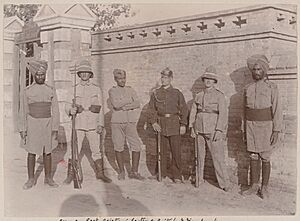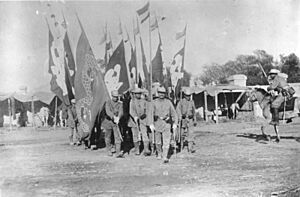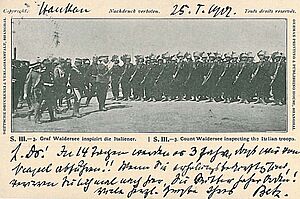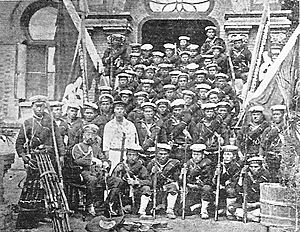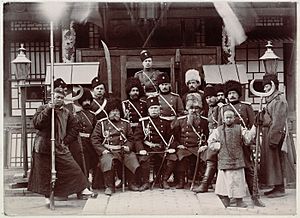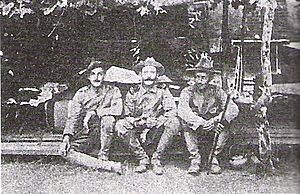Eight-Nation Alliance facts for kids
Quick facts for kids Eight-Nation Alliance |
|
|---|---|
| 八國聯軍 | |

The eight nations with their naval ensigns, from top to bottom, left to right:
|
|
| Active | 10 June 1900 – 7 September 1901 (1 year, 90 days) |
| Country | |
| Allegiance | None (individual) |
| Type | Expeditionary force |
| Role | To relieve a siege of various legations, suppress the Boxer Rebellion, and safeguard privileges of foreign nationals and Chinese Christians. |
| Size | About 51,755 troops |
| Nickname(s) | Coalition |
| Engagements | Boxer Rebellion |
| Commanders | |
| Notable commanders |
Second: First: |
| Eight Nation Alliance | |||||||||
|---|---|---|---|---|---|---|---|---|---|
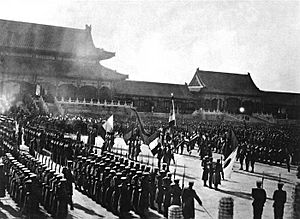
|
|||||||||
| Traditional Chinese | 八國聯軍 | ||||||||
| Simplified Chinese | 八国联军 | ||||||||
|
|||||||||
The Eight-Nation Alliance was a group of armies from eight different countries. They came together to invade northern China in 1900. Their main goal was to help foreign diplomats and citizens who were trapped in Beijing during the Boxer Rebellion. Chinese rebels called the Boxers wanted to remove foreign influence from their country.
The eight nations were Germany, Japan, Russia, Britain, France, the United States, Italy, and Austria-Hungary. About 45,000 soldiers joined this alliance. Neither China nor the foreign countries officially declared war. There was no formal agreement holding the alliance together.
Some historians say the first part of the fighting was like a civil war. This was because the Chinese government, called the Qing dynasty, started supporting the Boxers. After the alliance won, they stayed in China for over a year. They took many valuable items from Beijing and other parts of northern China. The fighting ended in 1901 when a peace agreement, called the Boxer Protocol, was signed.
Contents
History of the Alliance
Why the Alliance Formed
The Boxer Rebellion was a movement by Chinese peasants. They attacked and killed foreign missionaries, other foreign citizens, and Chinese Christians in northern China. This happened in 1899 and 1900. The Chinese government and its army supported the Boxers. They surrounded foreign diplomats and civilians in the Peking Legation Quarter in Beijing.
This area, where foreign embassies were located, was under attack for 55 days. This was from June 20 to August 14, 1900. About 473 foreign civilians, 409 soldiers from eight countries, and 3,000 Chinese Christians were trapped there. They defended themselves with small weapons and one old cannon. Chinese Christians found this cannon and gave it to the defenders. They called it the International Gun.
Another place under attack in Beijing was the North Cathedral, also known as the Beitang Church. It was defended by 43 French and Italian soldiers. Also, 33 foreign Catholic priests and nuns, and 3,200 Chinese Catholics were there. The defenders faced many challenges, including a lack of food. Chinese attackers also dug tunnels and used explosives under the church.
On August 14, 1900, the alliance marched to Beijing from Tianjin. Their goal was to rescue those trapped in the Legation Quarter.
Fighting and Aftermath
The allied troops entered and took control of Beijing on August 14, 1900. They defeated the Chinese Imperial Army. This quickly ended the siege and the Boxer Rebellion. The Chinese ruler, Empress Dowager Cixi, and other officials fled the Forbidden City. They went to Xi'an and sent a representative to talk about peace.
As the allied troops moved through Beijing and the countryside, they took many valuable items. They looted palaces, government buildings, and temples. This caused a huge loss of cultural treasures. Many old books, including the famous Yongle Dadian, were destroyed. Important places like the Forbidden City and the Summer Palace were also damaged.
For example, over 3,000 gold-plated statues of Buddha were taken from Songzhu Temple. The gold plating on copper tanks in front of the Forbidden City was scraped off. The Yongle Encyclopedia, a huge collection of books from the Ming dynasty, was completely destroyed. Parts of it were even used to build defenses.
Another large collection, the Complete Library of the Four Treasuries, also suffered. One set was destroyed earlier, and over 10,000 more volumes were destroyed by the alliance in 1900. The Hanlin Academy, which held many rare books and paintings, was also looted. Some of these stolen books are now in museums in London and Paris.
Member Nations of the Alliance
Austria-Hungary
Austria-Hungary had one warship, the SMS Zenta, in China when the rebellion started. Sailors from this ship were the only Austro-Hungarian forces to fight. Some helped defend the trapped diplomats. Others tried to rescue them.
In June, Austro-Hungarian forces helped protect the railway near Tianjin. They also attacked Chinese ships on the Hai River. They helped capture the Taku Forts, which guarded the way to Tianjin. After the main fighting ended, Austria-Hungary kept a warship and some marines in China.
British Empire
Britain was fighting another war in South Africa when the Boxer Rebellion began. So, they mostly used their navy and troops from India. The British forces were the third-largest group in the alliance. They included soldiers from the Royal Navy, Royal Field Artillery, and various Indian regiments.
Australian Colonies
Australia was not yet a single country in 1900. So, different Australian colonies sent their own soldiers and sailors. For example, South Australia sent its entire navy, which was one gunboat. Australian forces arrived too late for most of the major battles.
India
Britain sent about 10,000 troops. Many of these were Indian soldiers from different groups like the Sikhs and Gurkhas.
Germany
Germany had a naval base and trading port in China called Qingdao. When the rebellion started, Germany sent a small group of marines to Beijing and Tianjin. This was to protect German citizens. Later, Germany sent a larger force of about 15,000 soldiers. Most of these German troops arrived after the main fighting was over. They mostly helped keep order and fought against smaller groups of Boxers.
France
France sent three groups of marines from their colony in Indochina. These troops joined the 1st Brigade. More soldiers were sent from France later, but they arrived in September. By January 1901, these forces became the 16th Regiment of Colonial Infantry. They set up their headquarters in Tianjin.
Italy
Italy had tried to get a special area in China in 1898 but was refused. When the Boxer Rebellion started, Italian sailors from warships went to Beijing. Some helped the French defend a Catholic church. Others defended the European embassies during the siege. Italian sailors also helped capture the Taku forts and Tianjin.
Later, a larger group of about 2,000 Italian soldiers was sent from Italy. They included different types of infantry and engineers. These forces were called the Italian Royal Troops in China. They took part in many operations along the coast and inland. After the conflict, most Italian soldiers left China. Italy gained a special area in Tianjin and a fort.
Japan
Japan sent the largest number of troops to the alliance, about 20,840 soldiers and sailors. At first, Japan only had 215 troops in northern China. They were mostly marines. These Japanese marines joined the Seymour Expedition, which tried to reach Beijing but was stopped by Chinese forces.
The Japanese government was careful about sending many troops. They didn't want to upset other Western powers. But the British urgently asked Japan for more help. Britain was busy with another war and couldn't send many troops quickly. Japan agreed to send more soldiers after the British offered them money.
By August 14, when the siege of Beijing was lifted, Japan had 13,000 troops. This was the largest group in the alliance. Japanese soldiers fought well, but they sometimes suffered many casualties. For example, in the fighting at Tianjin, Japanese troops had more than half of the alliance's casualties.
Russia
Russia provided the second-largest force, with 12,400 troops. These soldiers mainly came from Russian bases in Port Arthur and Vladivostok. In November 1900, a Russian admiral made the Chinese governor of Shenyang sign an agreement. This agreement gave Russia control over a large area called Manchuria.
United States
In the United States, this conflict was known as the China Relief Expedition. The U.S. could help a lot because they had soldiers in the Philippines. These troops were there after the Spanish–American War. Among the foreigners trapped in Beijing were 56 American sailors and marines.
The main American forces sent to help were from the 9th and 14th Infantry regiments. They also included cavalry, artillery, and a Marine battalion. These forces were led by Colonel Adna Chaffee. Herbert Hoover, who later became a U.S. President, was living in Beijing during the siege. He helped build defenses and organize a protective force. His wife, Lou Henry Hoover, helped set up a hospital and cared for the wounded.
Images for kids



